Jung Han. Innovations in Food Packaging
Подождите немного. Документ загружается.

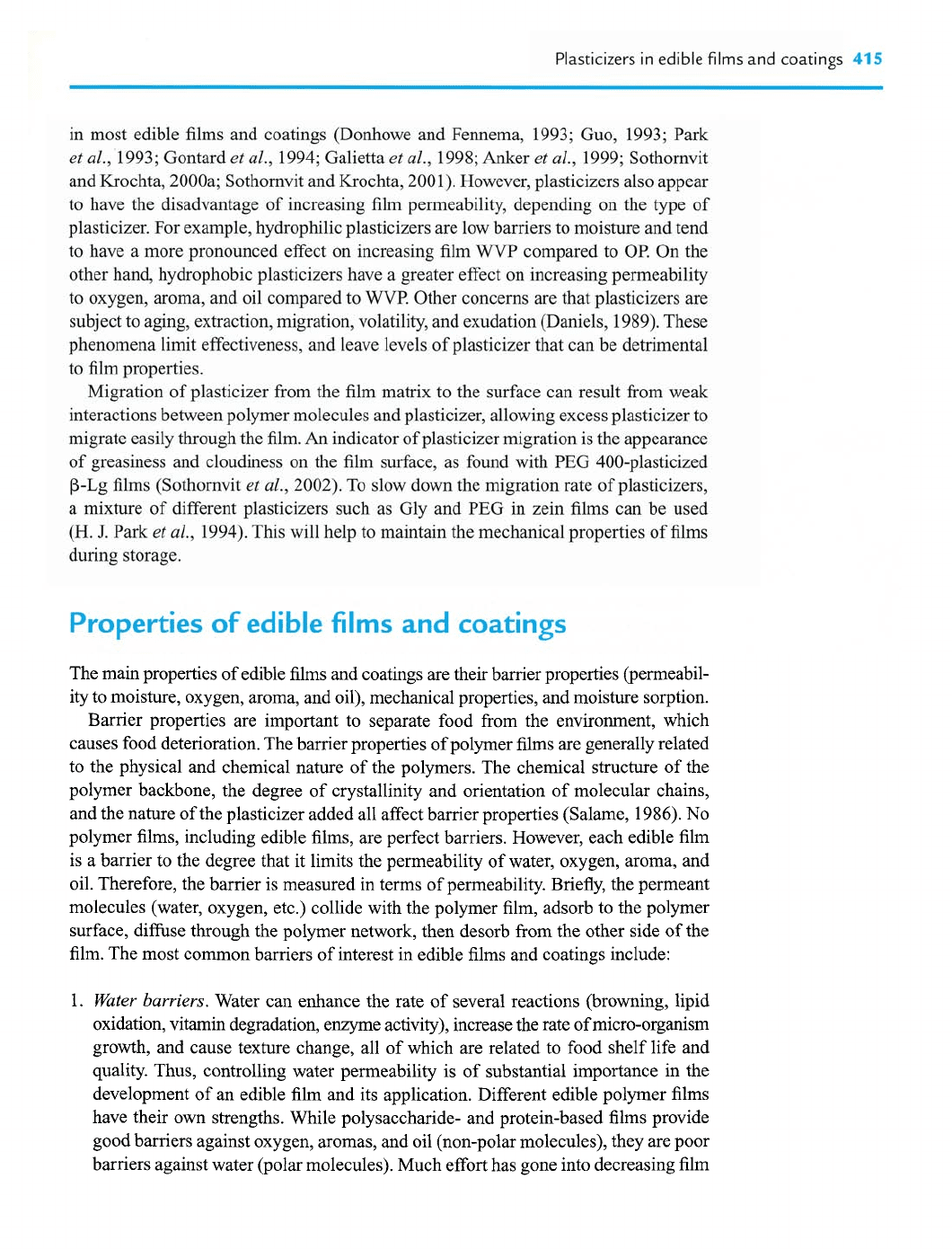
Plasticizers
in
edible films and coatings
415
in most edible films and coatings (Donhowe and Fennema, 1993; Guo, 1993; Park
et
al., 1993; Gontard
et
al., 1994; Galietta
et
al., 1998; Anker
et
al., 1999; Sothornvit
and Krochta, 2000a; Sothornvit and Krochta, 2001). However, plasticizers also appear
to have the disadvantage of increasing film permeability, depending on the type of
plasticizer. For example, hydrophilic plasticizers are low barriers to moisture
and
tend
to have a more pronounced effect on increasing film WVP compared to OP. On the
other hand, hydrophobic plasticizers have a greater effect on increasing permeability
to oxygen, aroma, and oil compared to
WVP.
Other concerns are that plasticizers are
subject to aging, extraction, migration, volatility, and exudation (Daniels, 1989). These
phenomena limit effectiveness, and leave levels of plasticizer that can be detrimental
to film properties.
Migration of plasticizer from the film matrix to the surface can result from weak
interactions between polymer molecules and plasticizer, allowing excess plasticizer to
migrate easily through the film.
An indicator of plasticizer migration is the appearance
of greasiness and cloudiness on the
film
surface, as found with PEG 400-plasticized
P-Lg films (Sothornvit
et
al., 2002). To slow down the migration rate of plasticizers,
a mixture of different plasticizers such as Gly and PEG in zein films can be used
(H.
J. Park
et
al., 1994). This will help to maintain the mechanical properties of films
during storage.
Properties
of
edible films and
coatings
The main properties of edible films and coatings are their barrier properties (permeabil-
ity to moisture, oxygen, aroma, and oil), mechanical properties, and moisture sorption.
Barrier properties are important to separate food from the environment, which
causes food deterioration. The barrier properties of polymer films are generally related
to the physical and chemical nature of the polymers. The chemical structure of the
polymer backbone, the degree of crystallinity and orientation of molecular chains,
and the nature of the plasticizer added all affect barrier properties (Salame, 1986). No
polymer films, including edible films, are perfect barriers. However, each edible film
is a barrier to the degree that it limits the permeability of water, oxygen, aroma, and
oil. Therefore, the barrier is measured in terms of permeability. Briefly, the permeant
molecules (water, oxygen, etc.) collide with the polymer film, adsorb to the polymer
surface, diffuse through the polymer network, then desorb from the other side of the
film. The most common barriers of interest in edible films and coatings include:
Water barriers.
Water can enhance the rate of several reactions (browning, lipid
oxidation,
vitamin
degradation, enzyme activity), increase the rate of micro-organism
growth, and cause texture change, all of which are related to food shelf life and
quality. Thus, controlling water permeability is of substantial importance in the
development of an edible film and its application. Different edible polymer films
have their own strengths. While polysaccharide- and protein-based films provide
good barriers against oxygen, aromas, and oil (non-polar molecules), they are poor
barriers against water (polar molecules). Much effort has gone into decreasing film

416
Innovations in Food Packaging
permeability to water vapor, such as combining polysaccharide or protein with
lipids, cross-linking with transglwninase, irradiation, and heat curing. While
adding lipid decreases polysaccharide- and protein-film
WVP,
modification of
these polymers mainly affects their mechanical properties. The type and amount of
plasticizer also affects the WVP. The potential applications of edible films include
coatings on fruits (e.g. apples, citrus hits, and pears) to prevent moisture loss and
improve gloss (Grant and Burns, 1994).
2. Oxygen barriers. Oxygen transfer from the environment to food affects the deteri-
oration of food components (lipids, vitamins, colors, and flavors) and micro-organism
growth (especially molds), leading to sensory and nutrient changes. Depending on
the formation materials used, the properties of edible films and coatings can be
adjusted to achieve each food application (Cuq et al., 1998). Most protein-based
films are excellent oxygen barriers. Nuts provide an example of the use of protein
films to avoid oxygen contact. Fruits and vegetables need a balance of oxygen and
carbon dioxide flow to control respiration and ripening. Generally speaking, films
that are better water barriers are poorer oxygen barriers. Increasing the plasticizer
amount always increases oxygen permeability through edible films, because of the
higher free volume in the film network.
3.
Grease/oil barriers. Greaseloil barrier packaging is essential for foods containing
fats or oils. Typically, synthetic polymers such as polyethylene
(PE)
are used to
provide grease resistance for coated paperboard. Biopolyrner-coated paperboard is an
alternative that can be used in fast-food packaging and for other forms of greaseloil
barrier packaging (Lin and Krochta, 2003).
Mechanical properties are important for edible films and film coatings, as they reflect
the durability of films and the ability of a coating to enhance the mechanical integrity of
foods. As discussed earlier, addition of plasticizers to biopolymers has a large effect on
film mechanical properties, such as increasing film flexibility and resilience.
Finally, moisture sorption is an important characteristic of hydrophilic films, since
the sorbed water acts as a plasticizer. Hydrophilic plasticizers increase the water-holding
capacity of the plasticized films, such as Gly-plasticized corn zein (Padua and Wang,
2002). The plasticizing effect of moisture sorption on edible films indicates that the
best applications for long-term food protection are for low water-activity foods.
Polysaccharide-based films and coatings
Polysaccharides used to form films and coatings are cellulose derivatives (e.g. methyl-
cellulose (MC), hydroxypropyl methylcellulose (HPMC), hydroxypropylcellulose
(HPC),
starches and starch derivatives (e.g. amylose, amylopectin, hydroxypropyl
amylose), and dextrins, pullulan, konjar, carrageenan, pectin, alginate, and other gums.
Polysaccharide-based films and coatings are hydrophilic, and thus exhibit poor water-
barrier properties. Nonetheless, polysaccharide films are good barriers against oxygen,
aromas, and oil at low to intermediate
RH.
They generally require plasticizers to achieve
the desirable mechanical properties.
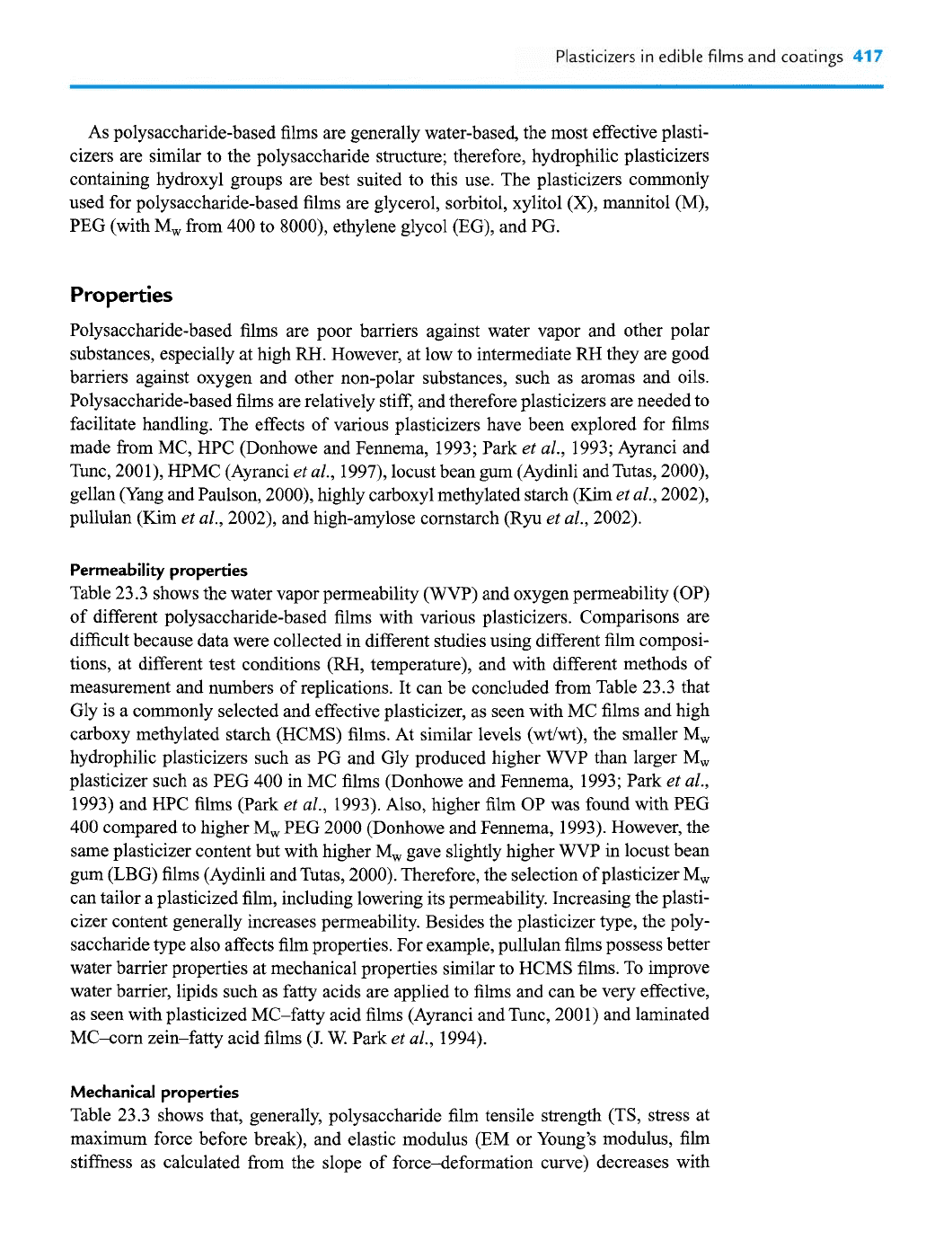
Plasticizers
in
edible films and coatings
417
As polysaccharide-based films are generally water-based, the most effective plasti-
cizers are similar to the polysaccharide structure; therefore, hydrophilic plasticizers
containing hydroxyl groups are best suited to this use. The plasticizers commonly
used for polysaccharide-based films are glycerol, sorbitol, xylitol
(X),
mannitol
(M),
PEG (with M, from 400 to 8000), ethylene glycol (EG), and PG.
Properties
Polysaccharide-based films are poor barriers against water vapor and other polar
substances, especially at high
RH.
However, at low to intermediate
RH
they are good
barriers against oxygen and other non-polar substances, such as aromas and oils.
Polysaccharide-based films are relatively stiff, and therefore plasticizers are needed to
facilitate handling. The effects of various plasticizers have been explored for films
made from MC, HPC (Donhowe and Fennema, 1993; Park
et
al., 1993; Ayranci and
Tunc, 2001), HPMC (Ayranci
et
al., 1997), locust bean
gum
(Aydinli and Tutas, 2000),
gellan (Yang and Paulson, 2000), highly carboxyl methylated starch
(Kim
et
al., 2002),
pullulan (Kim
et
al., 2002), and high-amylose cornstarch
(Ryu
et
al., 2002).
Permeability properties
Table 23.3 shows the water vapor permeability
(WVP)
and oxygen permeability (OP)
of different polysaccharide-based films with various plasticizers. Comparisons are
difficult because data were collected in different studies using different film composi-
tions, at different test conditions
(RH,
temperature), and with different methods of
measurement and numbers of replications. It can be concluded from Table 23.3 that
Gly is a commonly selected and effective plasticizer, as seen with MC films and high
carboxy methylated starch (HCMS) films. At similar levels
(wt/wt),
the smaller Mw
hydrophilic plasticizers such as PG and Gly produced higher WVP than larger Mw
plasticizer such as PEG 400 in MC films (Donhowe and Fennema, 1993; Park
et
al.,
1993) and HPC films (Park
et
al., 1993). Also, higher film OP was found with PEG
400 compared to higher Mw PEG 2000 (Donhowe and Fennema, 1993). However, the
same plasticizer content but with higher Mw gave slightly higher
WVP
in
locust bean
gum (LBG) films (Aydinli and Tutas, 2000). Therefore, the selection of plasticizer Mw
can tailor a plasticized film, including lowering its permeability. Increasing the plasti-
cizer content generally increases permeability. Besides the plasticizer type, the poly-
saccharide type also affects film properties. For example, pullulan films possess better
water barrier properties at mechanical properties similar to HCMS films. To improve
water barrier, lipids such as fatty acids are applied to films and can be very effective,
as seen with plasticized MC-fatty acid films (Ayranci and Tunc, 2001) and laminated
MC*orn zein-fatty acid films
(J.
W.
Park
et
al., 1994).
Mechanical properties
Table 23.3 shows that, generally, polysaccharide film tensile strength (TS, stress at
maximum force before break), and elastic modulus (EM or Young's modulus, film
stiffness as calculated from the slope of force-deformation curve) decreases with
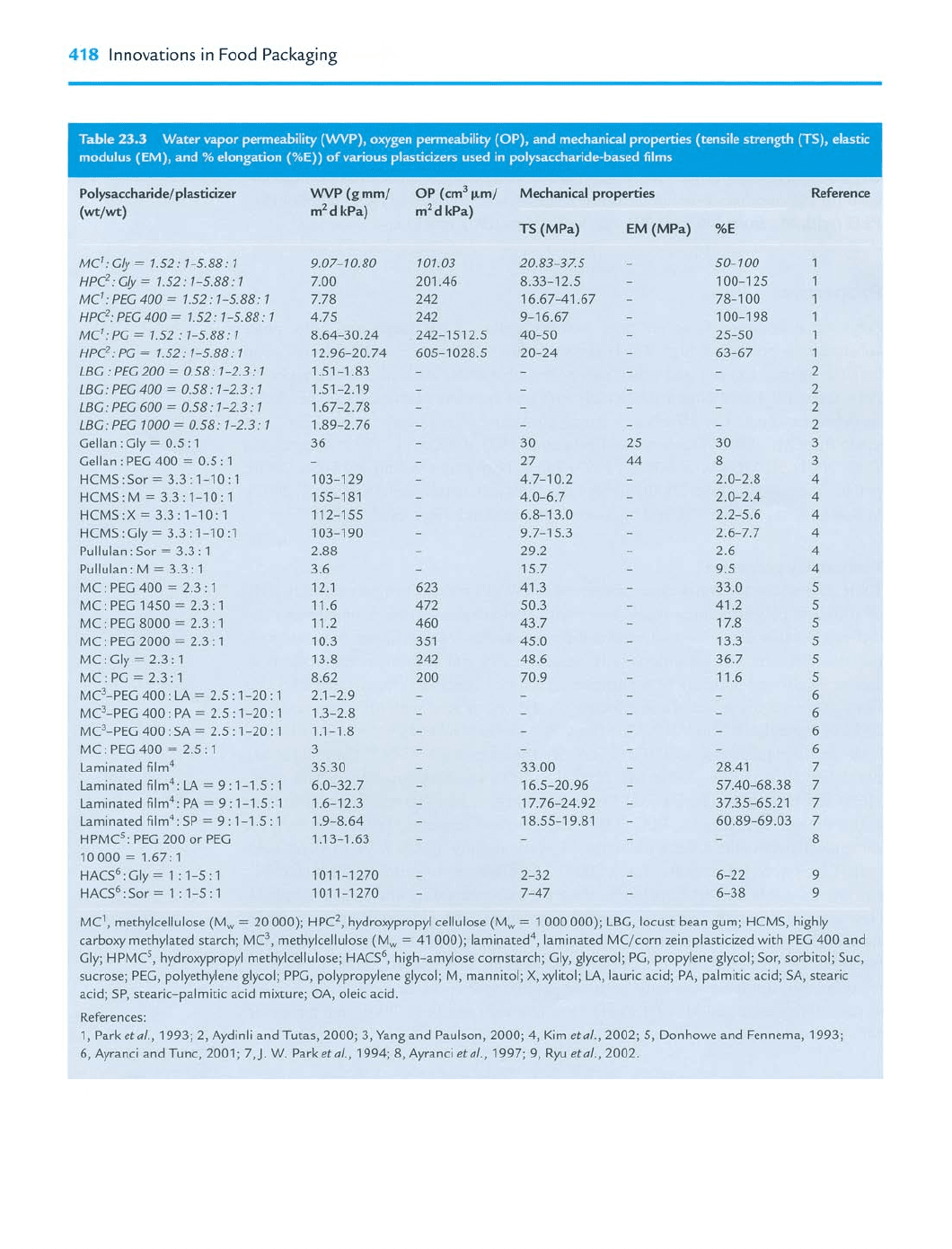
418
Innovations in Food Packaging
Polysaccharide/plasticizer
WVP
(gmm/ OP (cm3p,m/ ties Reference
(Wt/Wt)
m
m2d kPa)
%E
I
vl~' :Gly
=
1.52: 1-5.88: 1 9.07-70.80 101.03
-
50-100 1
iPC2:~ly
=
1.52: 1-5.88: 1 7.00 201.46
-
100-1 25 1
vlC1: PEG 400
=
1.52
:
1-5.88:
1
7.78 242 67
-
78-1 00 1
+PC':
PEG
400
=
1.52: 1-5.88:
1
4.75 242 67
-
100-1 98 1
vlC7:pG
=
1.52
:
1-5.88: 1 8.64-30.24
.
242-1 51 2.5
4U-50
-
25-50 1
+P@:PG
=
1.52: 1-5.88:
1
12.96-20.74 605-1 028.5 20-24
-
63-67 1
.BG :PEG 200
=
0.58: 1-2.3: 1 1.51-1.83
-
-
-
-
2
.BG: PEG 400
=
0.58: 1-2.3: 1 1.51-2.19
- -
-
-
2
.BG:PEG 600
=
0.58: 1-2.3:
1
1.67-2.78
-
-
-
-
2
.BG:PEG 1000
=
0.58: 1-2.3: 1 1.89-2.76
-
-
-
-
2
iellan
:
Gly
=
0.5
:
1 36
-
30 25 30 3
;ellan
:
PEG 400
=
0.5
:
1
-
-
27 44 8 3
4CMS:Sor
=
3.3:l-10:l 103-1 29
-
4.7-10.2
-
2.0-2.8
4
4CMS:M
=
3.3:l-10:l 155-1 81
-
4.0-6.7
-
2.0-2.4 4
-ICMS:X= 3.3:l-10:l 11 2-1 55
-
6.8-13.0
-
2.2-5.6 4
-ICMS:Gly
=
3.3: 1-10:l 103-1 90
-
9.7-1 5.3
-
2.6-7.7 4
)ullulan
:
Sor
=
3.3
:
1 2.88
-
29.2
-
2.6 4
'ullulan
:
M
=
3.3
:
1 3.6
-
15.7
-
9.5 4
vIC: PEG 400
=
2.3
:
1 12.1 623 41.3
-
33.0 5
4C:PEG 1450
=
2.3:l 11.6 472 50.3
-
41.2 5
vIC: PEG 8000
=
2.3
:
1 11.2 460 43.7
-
17.8 5
vIC
:
PEG 2000
=
2.3
:
1 10.3 351 45.0
-
13.3 5
vIC:Gly
=
2.3:l 13.8 242 48.6
-
36.7 5
vIC
:
PC
=
2.3
:
1 8.62 200 70.9
-
11.6
5
V~C~-PEG
400
:
LA
=
2.5
:
1-20
:
1 2.1-2.9
-
-
-
-
6
YIC~-PEG 400: PA
=
2.5
:
1-20: 1 1.3-2.8
-
-
-
-
6
VIC~-PEG
400:SA
=
2.5: 1-20:? 1.1-1.8
-
-
- -
6
vlC:PEG400
=
2.5:l 3
-
- -
-
6
aminated film4 35.30
-
33.00
-
28.41 7
aminated film4:
LA
=
9
:
1-1.5: 1 6.0-32.7
-
16.5-20.96
-
57.40-68.38 7
aminated film4: PA
=
9
:
1-1.5: 1 1.6-12.3
-
17.76-24.92
-
37.35-65.21 7
aminated film4:sp
=
9
:
1-1.5: 1 1.9-8.64
-
18.55-19.81
-
60.89-69.03 7
~PMC': PEG 200 or PEG 1
.I
3-1.63
-
-
-
-
8
10000
=
1.67: 1
-IACS~:GI~
=
1 :I-$:I 1011-1270
-
2-32
-
22 9
-IACS~:SO~
=
1 :I-5:l 1011-1270
-
7-47
-
38
9
vl~',
methylcellulose (M,
=
20 000); HPC', hydroxypropyl cellulose (M,
=
1 000000); LBG, loc
m; HCMS, highly
:arboxy rnethylated starch;
MC~,
methylcellulose (M,
=
41 000); laminated4, laminated MC/corn zein plasticized with PEG 400 and
lly; HPMC', hydroxypropyl methylcellulose;
HACS~,
high-amylose cornstarch; Gly, glycerol; PC, propylene glycol; Sor, sorbitol; Suc,
;ucrose; PEG, polyethylene glycol; PPC, polypropylene glycol; M, mannitol;
X,
xylitol;
LA,
lauric acid; PA, palmitic acid; SA, stearic
icid; SP, stearic-palmitic acid mixture; OA, oleic acid.
Lferences:
I,
Park
eta/.,
1993; 2, Aydinli and Tutas, 2000; 3, Yang and Paulson, 2000; 4, Kim
etal.,
2002; 5, Donhowe and Fennema, 1993;
6,
Ayranci and Tunc, 2001
;
7,
J.
W.
Park
et
a/.,
1994; 8, Ayranci
etal.,
1997; 9,
Ryu
etal.,
2002.
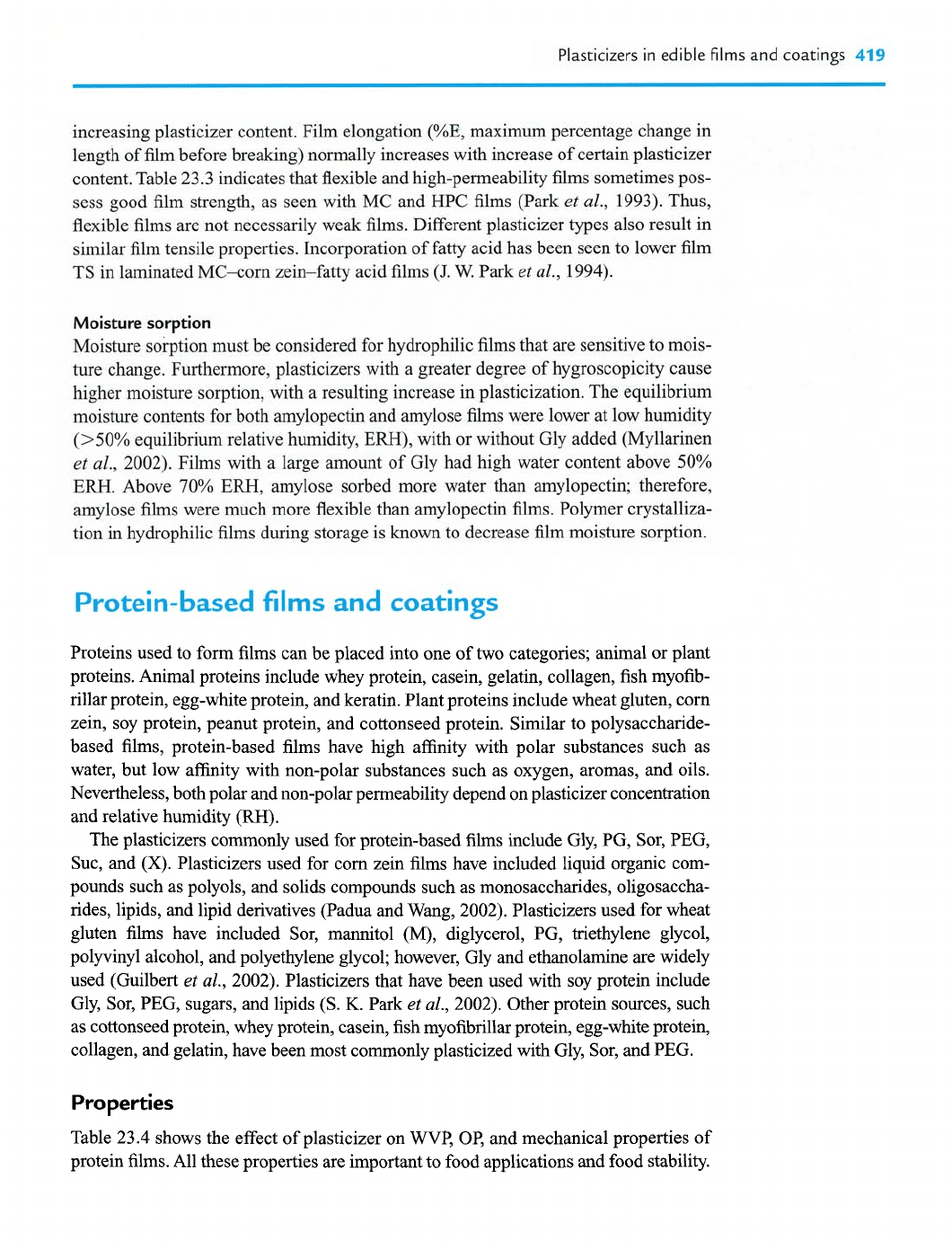
Plasticizers
in
edible films
and
coatings
419
increasing plasticizer content. Film elongation
(%E,
maximum percentage change in
length of film before breaking) normally increases with increase of certain plasticizer
content. Table
23.3
indicates that flexible and high-permeability films sometimes pos-
sess good film strength, as seen with MC and HPC films (Park
et
al., 1993). Thus,
flexible films are not necessarily weak films. Different plasticizer types also result in
similar film tensile properties. Incorporation of fatty acid has been seen to lower film
TS in laminated MC+orn zein-fatty acid films
(J.
W.
Park
et
al., 1994).
Moisture sorption
Moisture sorption must be considered for hydrophilic films that are sensitive to mois-
ture change. Furthermore, plasticizers with a greater degree of hygroscopicity cause
higher moisture sorption, with a resulting increase in plasticization. The equilibrium
moisture contents for both amylopectin and amylose films were lower at low humidity
(>50% equilibrium relative humidity, ERH), with or without Gly added (Myllarinen
et
al., 2002). Films with a large amount of Gly had high water content above 50%
ERH. Above 70% ERH, amylose sorbed more water than amylopectin; therefore,
amylose films were much more flexible than amylopectin films. Polymer crystalliza-
tion in hydrophilic films during storage is known to decrease film moisture sorption.
Protein-based
films
and coatings
Proteins used to form films can be placed into one of two categories; animal or plant
proteins. Animal proteins include whey protein, casein, gelatin, collagen, fish myofib-
rillar protein, egg-white protein, and keratin. Plant proteins include wheat gluten, corn
zein, soy protein, peanut protein, and cottonseed protein. Similar to polysaccharide-
based films, protein-based films have high affinity with polar substances such as
water, but low affinity with non-polar substances such as oxygen, aromas, and oils.
Nevertheless, both polar and non-polar permeability depend on plasticizer concentration
and relative humidity (RH).
The plasticizers commonly used for protein-based films include Gly, PG, Sor, PEG,
Suc, and
(X).
Plasticizers used for corn zein films have included liquid organic com-
pounds such as polyols, and solids compounds such as monosaccharides, oligosaccha-
rides, lipids, and lipid derivatives (Padua and Wang, 2002). Plasticizers used for wheat
gluten films have included Sor, mannitol
(M),
diglycerol, PG, triethylene glycol,
polyvinyl alcohol, and polyethylene glycol; however, Gly and ethanolamine are widely
used (Guilbert
et
al.,
2002). Plasticizers that have been used with soy protein include
Gly, Sor, PEG, sugars, and lipids (S.
K.
Park
et
al.,
2002). Other protein sources, such
as cottonseed protein, whey protein, casein, fish myofibrillar protein, egg-white protein,
collagen, and gelatin, have been most commonly plasticized with Gly, Sor, and PEG.
Properties
Table
23.4
shows the effect of plasticizer on
WVP,
OP, and mechanical properties of
protein films. All these properties are important to food applications and food stability.
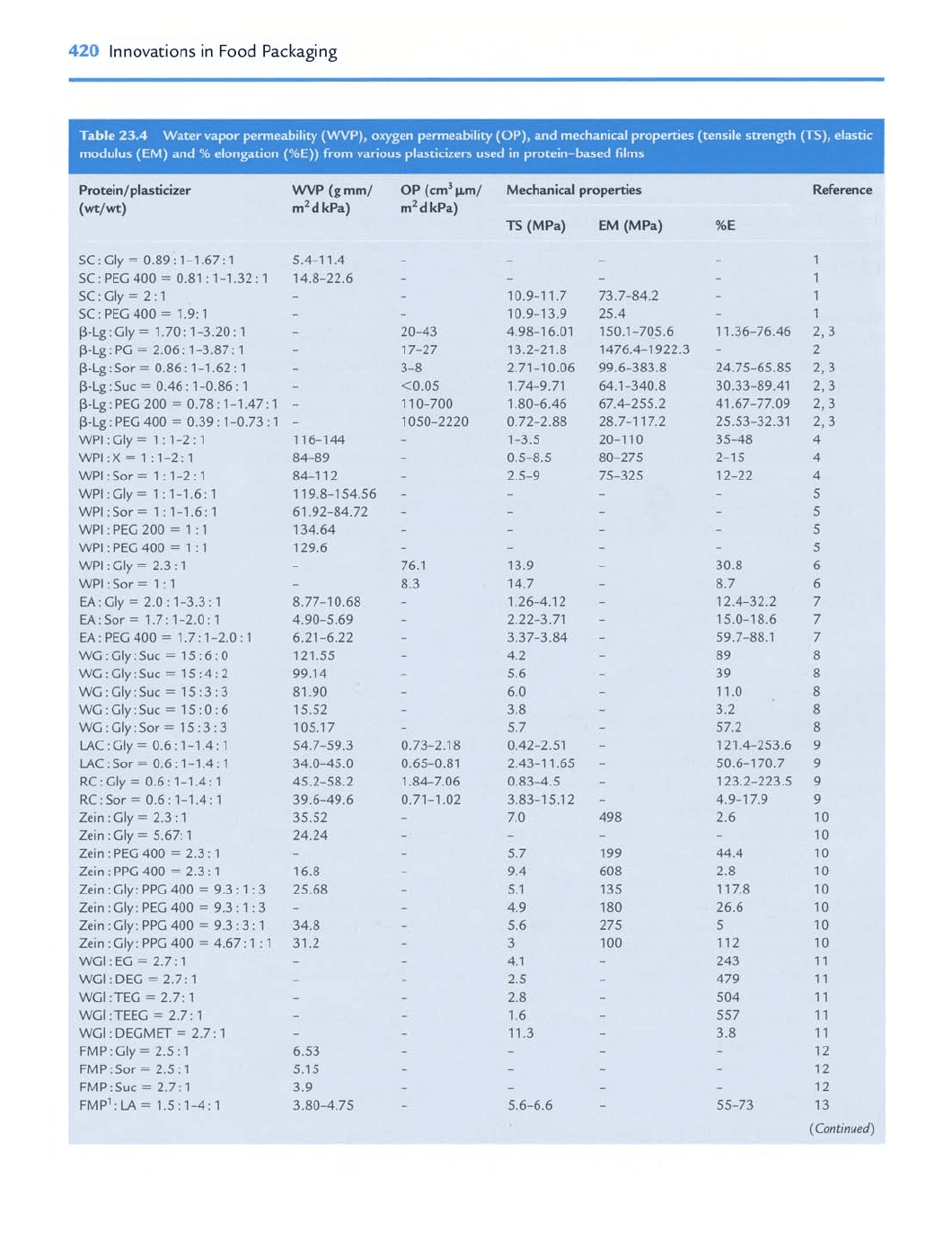
420
Innovations in Food Packaging
rable
23.4
Water vapor permeability (WVP), oxygen permeability (OP), and mechanical properties (tensile strength
(TS),
elastic
nodulus (EM) and
%
elongation (%E)) from various plasticizers used in protein-based films
Mechanical properties
TS
(MPa) EM (MPa)
Reference
I
SC:Gly
=
0.89 11-1.67: 1
5.4-1 1.4
SC
:
PEG 400
=
0.81
:
1-1.32
:
1 14.8-22.6
SC:Gly
=
2: 1
-
SC:PEG400
=
1.9:l
-
$-Lg: Gly
=
1.70
:
1-3.20
:
1
$-Lg: PC
=
2.06
:
1-3.87: 1
$-Lg: Sor
=
0.86
:
1-1.62
:
1
-
$-Lg:Suc
=
0.46: 1-0.86: 1
-
$-Lg: PEG 200
=
0.78
:
1-1.47: 1
-
$-Lg: PEG 400
=
0.39
:
1-0.73
:
1
-
WPI:Gly
=
1:l-2:l 116-144
WPI:X= 1:l-2:l 84-89
WPI:Sor= 1 :1-2:l 84-1 12
WPI:Gly
=
1:l-1.6:l 11 9.8-1 54.56
WPI:Sor
=
1 :1-1.6:l 61.92-84.72
WPI
:
PEG 200
=
1
:
1
134.64
WPI
:
PEG 400
=
1
:
1 129.6
WPI
:
Gly
=
2.3
:
1
-
WPI:Sor
=
1
:I
-
EA:Gly
=
2.0
:
1-3.3: 1 8.77-1 0.68
EA:Sor
=
1.7: 1-2.0: 1 4.90-5.69
EA
:
PEG 400
=
1.7: 1-2.0
:
1 6.21-6.22
WG:Gly:Suc
=
15:6:0 121.55
WG:Gly:Suc
=
15:4:2 99.1 4
WG:Gly:Suc
=
15:3:3 81.90
WG:Gly:Suc
=
15:0:6 15.52
WG:Gly:Sor
=
15:3:3 105.1 7
LAC:Gly
=
0.6: 1-1.4: 1
54.7-59.3
LAC:Sor
=
0.6: 1-1.4: 1
34.0-45.0
RC:Gly
=
0.6: 1-1.4: 1 45.2-58.2
RC:Sor
=
0.6:l-1.4:l 39.6-49.6
Zein
:
Gly
=
2.3
:
1 35.52
Zein
:
Gly
=
5.67: 1 24.24
Zein
:
PEG 400
=
2.3
:
1
-
Zein
:
PPG 400
=
2.3
:
1 16.8
Zein
:
Gly: PPG 400
=
9.3
:
1
:
3 25.68
Zein
:
Gly: PEG 400
=
9.3
:
1
:
3
-
Zein
:
Gly: PPG 400
=
9.3
:
3
:
1 34.8
Zein: Gly: PPG 400
=
4.67: 1
:
I
31.2
WGI:EC
=
2.7:l
-
WGI: DEG
=
2.7: 1
-
WGI :TEG
=
2.7: 1
-
WGI :TEEG
=
2.7: 1
-
WGI
:
DEGMET
=
2.7: 1
-
FMP:Gly
=
2.5: 1 6.53
FMP:Sor
=
2.5: 1 5.1 5
FMP:Suc
=
2.7: 1 3.9
CMP':W
=
1.5:1-4:1 3.80-4.75
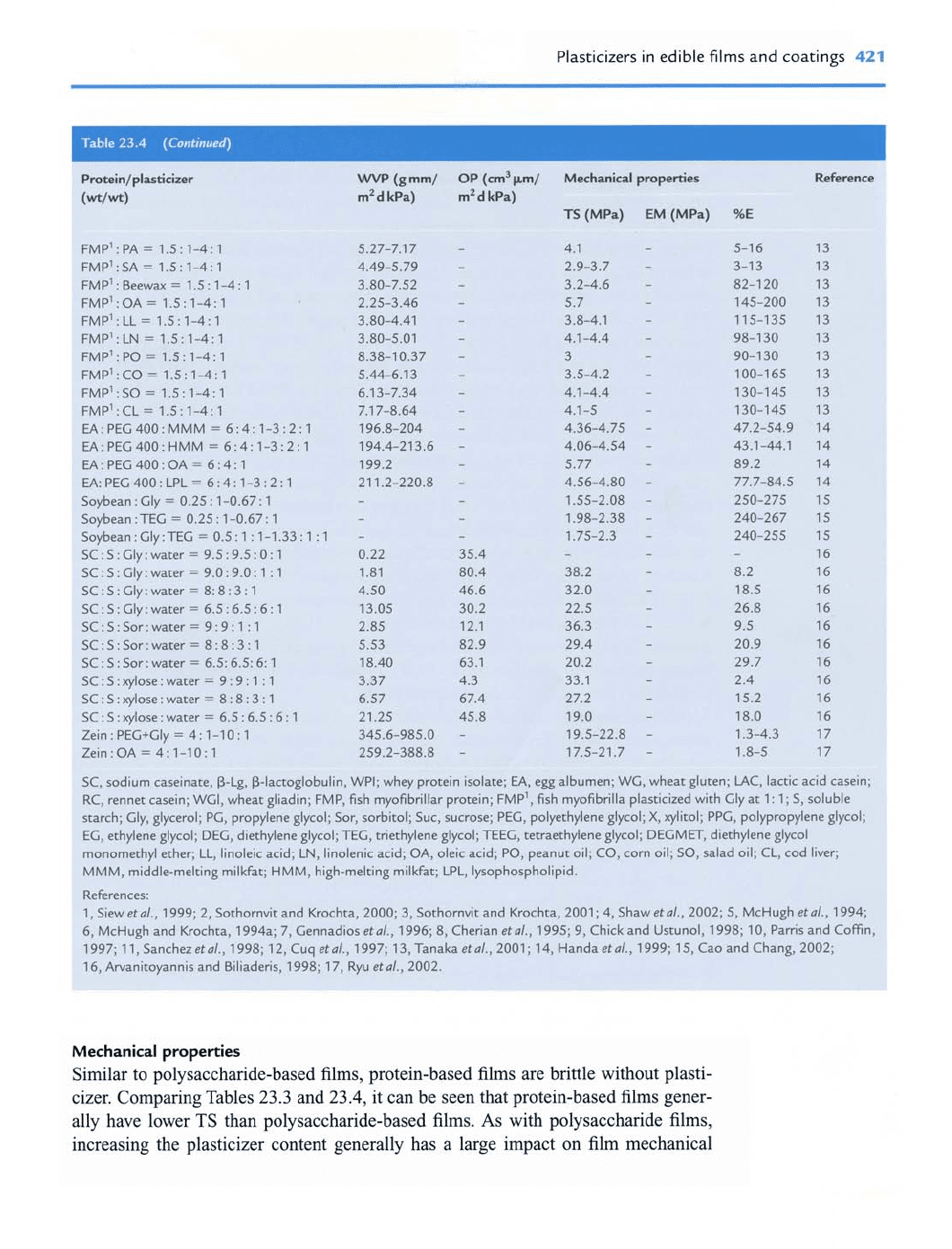
Plasticizers in edible films and coatings
421
rble
23.4
(Continued)
Proteinlplasticizer
WVP
(g
mml OP (cm3 pml Mechanical properties Reference
I
I
(wt/w)
m2 d kPa) m2d
kPa)
TS
(MPa) EM (MPa) %E
FMP':PA= 1.5:1-4:l
5.27-7.17
-
4.1
-
5-1 6 13
FMP1:SA
=
1.5:l-4:l
4.49-5.75
-
2.9-3.7
-
3-13 13
~M~':~eewax= 1.5:l-4:l
3.80-7.52
-
3.2-4.6
-
82-120 13
FMP':OA
=
1.5:l-4:l
2.25-3.46
-
5.7
-
145-200 13
FMP1:LL
=
1.5:l-4:l
3.80-4.41
-
3.8-4.1
-
115-135 13
I
FMP':LN
=
1.5:l-4:l
3.80-5.01
-
4.1-4.4
-
98-130 13
FMP':PO
=
1.5:l-4:l
8.38-10.37
-
3
-
90-130 13
FMP':CO
=
1.5:l-4:l
5.44-6.13
-
3.5-4.2
-
100-165 13
FMP':SO
=
1.5:l-4:l
6.13-7.34
-
4.1-4.4
-
130-145 13
FMP':CL= 1.5:l-4:l
7.1 7-8.64
-
4.1-5
-
130-145 13
EA:PEG400:MMM
=
6:4:1-3:2:1
196.8-204
-
4.36-4.75
-
47.2-54.9 14
EA:PEG400:HMM =6:4:1-3:2:1
194.4-213.6
-
4.06-4.54
-
43.1-44.1 14
EA:PEG400:OA
=
6:4:1
199.2
-
5.77
-
89.2 14
EA:PEC400:LPL= 6:4:1-3:2:1
21 1.2-220.8
-
4.56-4.80
-
77.7-84.5 14
Soybean
:
Gly
=
0.25
:
1-0.67: 1
-
-
1.55-2.08
-
250-275 15
Soybean :TEC
=
0.25
:
1-0.67: 1
-
-
1.98-2.38
-
240-267 15
Soybean:Cly:TEG
=
0.5: 1
:
1-1.33: 1
:
1
-
-
1.75-2.3
-
240-255 15
SC:S:Gly:water
=
9.5:9.5:0:1 0.22
35.4
-
-
-
16
SC:S:Cly:water
=
9.0:9.0:1
:l
1.81
80.4 38.2
-
8.2 16
SC:S:Cly:water= 8:8:3:1
4.50
46.6 32.0
-
18.5 16
SC
:
S
:
Cly
:
water
=
6.5
:
6.5
:
6
:
1
13.05
30.2 22.5
-
26.8 16
SC:S:Sor:water= 9:9:1 :1
2.85
12.1 36.3
-
9.5 16
SC:S:Sor:water
=
8:8:3:1
5.53
82.9 29.4
-
20.9 16
SC: S :Sor: water
=
6.5: 6.5: 6: 1 18.40
63.1 20.2
-
29.7 16
SC:S:xylose:water
=
9:9:1 :1
3.37
4.3 33.1
-
2.4 16
SC:S:xylose:water
=
8:8:3:1
6.57
67.4 27.2
-
15.2 16
SC
:
S
:
xylose :water
=
6.5
:
6.5
:
6
:
1 21.25
45.8 19.0
-
18.0 16
Zein: PEC+Cly
=
4: 1-10: 1
345.6-985.0
-
19.5-22.8
-
1.3-4.3 17
Zein:OA= 4:l-10:l
259.2-388.8
-
17.5-21.7
-
1.8-5 17
SC, sodium caseinate, P-Lg, P-lactoglobulin, WPI; whey protein isolate; EA, egg albumen; WC, wheat gluten; LAC, lactic acid casein;
RC, rennet casein; WCI, wheat gliadin; FMP, fish myofibrillar protein;
FMP',
fish myofibrilla plasticized with Cly at 1: 1; S, soluble
starch; Cly, glycerol; PC, propylene glycol; Sor, sorbitol; Suc, sucrose; PEG, polyethylene glycol;
X,
xylitol; PPG, polypropylene glycol;
EG, ethylene glycol; DEG, diethylene glycol; TEC, triethylene glycol; TEEC, tetraethylene glycol; DECMET, diethylene glycol
monomethyl ether; LL, linoleic acid; LN, linolenic acid; OA, oleic acid; PO, peanut oil; CO, corn oil; SO, salad oil; CL, cod liver;
MMM, middle-melting milkfat; HMM, high-melting milkfat; LPL, lysophospholipid.
1, Siew
et a/.,
1999; 2, Sothornvit and Krochta, 2000; 3, Sothornvit and Krochta, 2001
;
4, Shaw
et
a/.,
2002; 5, McHugh
eta/.,
1994;
6, McHugh and Krochta, 1994a; 7, Cennadios
etal.,
1996; 8, Cherian
etal.,
1995; 9, Chick and Ustunol, 1998; 10, Parris and Coffin,
1997; 1 1, Sanchez
etal.,
1998; 12, Cuq
etal.,
1997; 13, Tanaka
etal.,
2001
;
14, Handa
etal.,
1999; 15, Cao and Chang, 2002;
Mechanical properties
Similar to polysaccharide-based films, protein-based films are brittle without plasti-
cizer. Comparing Tables 23.3 and 23.4, it can be seen that protein-based films gener-
ally have lower TS than polysaccharide-based films.
As
with polysaccharide films,
increasing the plasticizer content generally has a large impact on film mechanical
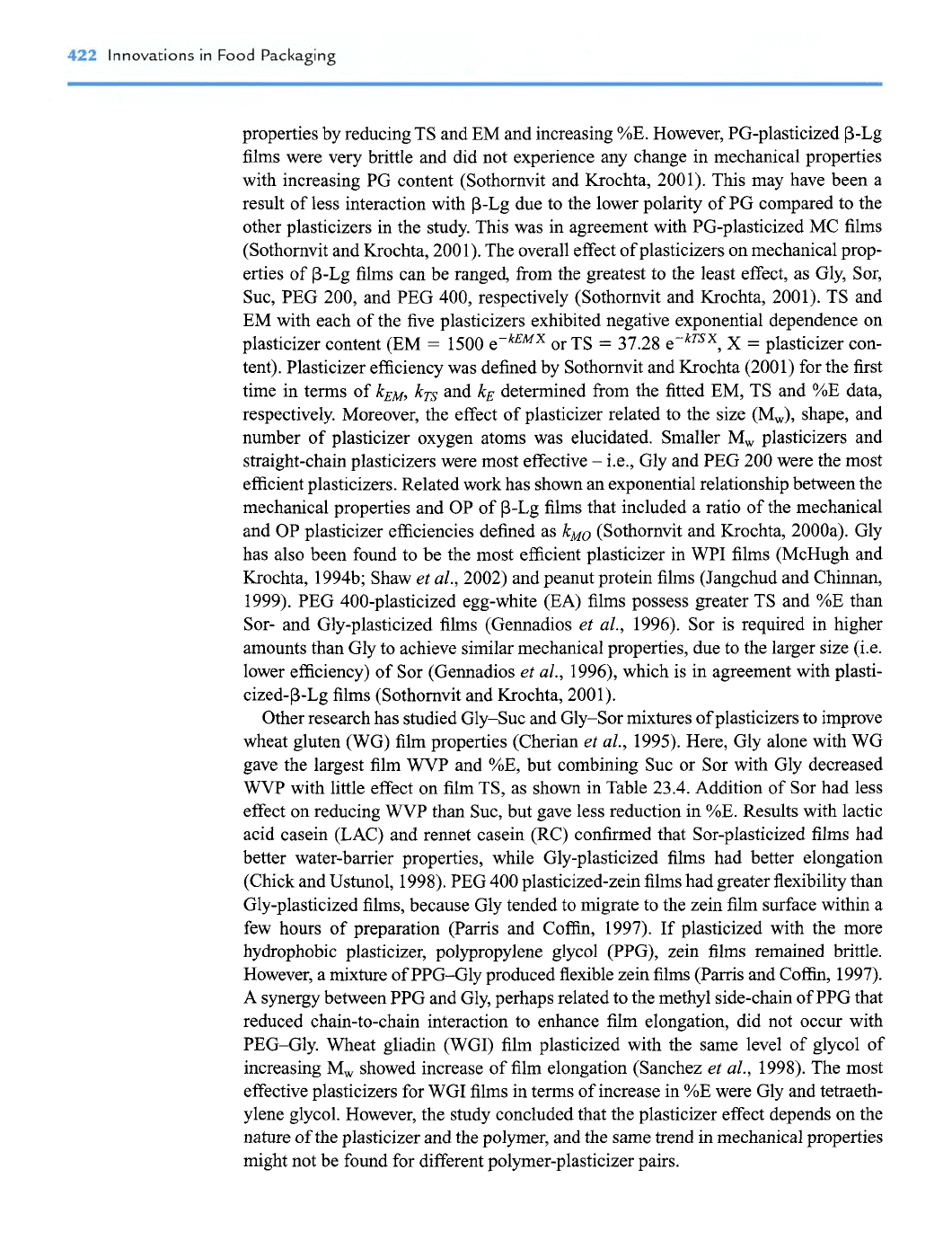
,nnovations in
Food
Packaging
properties by reducing TS and EM and increasing %E. However, PG-plasticized P-Lg
films were very brittle and did not experience any change in mechanical properties
with increasing PG content (Sothornvit and Krochta, 2001). This may have been a
result of less interaction with P-Lg due to the lower polarity of PG compared to the
other plasticizers in the study. This was in agreement with PG-plasticized MC films
(Sothornvit and Krochta, 2001). The overall effect of plasticizers on mechanical prop-
erties of P-Lg films can be ranged, from the greatest to the least effect, as Gly, Sor,
Suc, PEG 200, and PEG 400, respectively (Sothornvit and Krochta, 2001). TS and
EM with each of the five plasticizers exhibited negative exponential dependence on
plasticizer content (EM
=
1500 eCkEMX or TS
=
37.28 eekTSX, X
=
plasticizer con-
tent). Plasticizer efficiency was defined by Sothornvit and Krochta (2001) for the first
time in terms of kEM, kTs and kE determined from the fitted EM, TS and %E data,
respectively. Moreover, the effect of plasticizer related to the size (M,), shape, and
number of plasticizer oxygen atoms was elucidated. Smaller Mw plasticizers and
straight-chain plasticizers were most effective
-
i.e., Gly and PEG 200 were the most
efficient plasticizers. Related work has shown an exponential relationship between the
mechanical properties and OP of P-Lg films that included a ratio of the mechanical
and OP plasticizer efficiencies defined as kMo (Sothornvit and Krochta, 2000a). Gly
has also been found to be the most efficient plasticizer in WPI films (McHugh and
Krochta, 1994b; Shaw
et
al., 2002) and peanut protein films (Jangchud and Chinnan,
1999). PEG 400-plasticized egg-white (EA) films possess greater TS and %E than
Sor- and Gly-plasticized films (Gennadios
et
al., 1996). Sor is required in higher
amounts than Gly to achieve similar mechanical properties, due to the larger size (i.e.
lower efficiency) of Sor (Gennadios
et
al., 1996), which is in agreement with plasti-
cized-P-Lg films (Sothornvit and Krochta, 2001).
Other research has studied Gly-Suc and Gly-Sor mixtures of plasticizers to improve
wheat gluten (WG) film properties (Cherian
et
al., 1995). Here, Gly alone with WG
gave the largest film
WVP
and %E, but combining Suc or Sor with Gly decreased
WVP
with little effect on film TS, as shown in Table 23.4. Addition of Sor had less
effect on reducing
WVP
than Suc, but gave less reduction in %E. Results with lactic
acid casein (LAC) and rennet casein (RC) confirmed that Sor-plasticized
films
had
better water-barrier properties, while Gly-plasticized films had better elongation
(Chick and Ustunol, 1998). PEG 400 plasticized-zein films had greater flexibility than
Gly-plasticized films, because Gly tended to migrate to the zein film surface within a
few hours of preparation (Parris and Coffin, 1997). If plasticized with the more
hydrophobic plasticizer, polypropylene glycol (PPG), zein films remained brittle.
However, a mixture of PPG-Gly produced flexible zein films (Parris and Coffin, 1997).
A synergy between PPG and Gly, perhaps related to the methyl side-chain of PPG that
reduced chain-to-chain interaction to enhance film elongation, did not occur with
PEG-Gly. Wheat gliadin (WGI) film plasticized with the same level of glycol of
increasing Mw showed increase of film elongation (Sanchez
et
al., 1998). The most
effective plasticizers for WGI films in terms of increase in %E were Gly and tetraeth-
ylene glycol. However, the study concluded that the plasticizer effect depends on the
nature of the plasticizer and the polymer, and the same trend in mechanical properties
might not be found for different polymer-plasticizer pairs.

Plasticizers in
edible
films
and
coatings
423
Incorporating fatty acids and other lipids was found to improve the tensile strength
of fish myofibrillar protein (FMP) films (Tanaka
et
al., 2001), egg albumin (EA) films
(Handa
et
al., 1999), and soybean films (Cao and Chang, 2002). Unsaturated fatty
acids (linoleic acid, LL; linolenic acid, LN), except for oleic acid (OA), decreased the
TS of FMP films; however, fatty acid content did not exhibit any change in film TS
(Tanaka
et
al., 2001). Beeswax and saturated fatty acids (palmitic acid, PA; stearic
acid, SA), except lauric acid (LA), decreased the TS of FMP films (Tanaka
et
al., 2001).
It was observed that increasing the M, of saturated fatty acids dramatically reduced
the film flexibility. Edible oils (peanut oil, PO; corn oil, CO; salad oil, SO; and cod
liver oil, CL) decreased TS as well. It can be concluded from this study that fatty acids
and other lipids produce flexible films with a certain level of lipids. Generally, the
main purpose of using fatty acids and other lipids is for a water barrier.
Permeability properties
Protein-based films have polar hydrophilic characteristics; consequently, they have
poor water vapor barrier properties but good oxygen-, aroma-, and oil-barrier proper-
ties. Increasing the plasticizer content of protein films increases permeability. At sim-
ilar plasticizer contents, sodium caseinate (SC) films plasticized with PEG 400 had
higher
WW
than films plasticized with Gly (Siew
et
al., 1999). The effects of various
plasticizers on the OP of P-Lg films using different bases of comparison have been
studied. The bases of comparison used were mole of plasticizer multiplied by the
number of oxygen atoms per mole of P-Lg (Figure 23.la); mole of plasticizer per
mole of P-Lg (Figure 23.lb); and mass of plasticizer per mass of P-Lg (Figure 23.1~)
(Sothornvit and Krochta, 2000b). Plasticizer size, shape, and number of plasticizer
oxygen atoms were shown to have a significant effect on plasticizer efficiency (kop).
The relationship between OP
data
and plasticizer amount was linear on all three bases
(Figure 23.1). Plasticizer efficiency for OP (kop) of P-Lg films, from low to high effi-
ciency values, is in the following order for all bases: Suc
<
Sor
<
PG, Gly
<
PEG
200
<
PEG 400. PG and Gly did not give any significant difference in OP, likely due
to their similarity of plasticizer structure and hygroscopicity. Sor possesses a larger
size and lower hygroscopicity than Gly, resulting in lower OP values and correspond-
ingly higher tensile properties (TS and EM). PEG 400-plasticized P-Lg films exhibited
higher OP than PEG 200-plasticized films, reflecting their larger and less efficient
size. The relationship between OP and the mechanical properties of P-Lg films was
expressed in terms of plasticizer efficiency ratios (kMo
=
kEdkoP or kTSJkoP), which
were used in a negative exponential correlation (EM
=
1500 e-(k~&~p)~~ or
TS
=
37.28 e-(kz@op)~~). Suc- and Sor-plasticized f3-Lg films were the best oxygen
barriers. High plasticizer efficiency ratios are desirable because they reflect a plasti-
cizer's ability to improve film flexibility while having little effect on OP (Sothornvit
and Krochta, 2000b).
In other studies comparing plasticizers at similar content in films, Gly gave higher
WW
in WPI films (McHugh
et
al., 1994; Shaw
et
al., 2002), LAC and RC films
(Chick and Ustunol, 1998), and FMP films (Cuq
et
al., 1997). Gly also gave higher

424
Innovations
in
Food Packaging
0 200 400 600 800 1000 1200
(a) Mole plast-0-atomlmole P-Lg
0 20 40 60 80 100 120 140
(b)
Mole plastlmole P-Lg
0 0.5
1
1.5 2 2.5
3
(c)
Mass plastlmass P-Lg
Figure
23.1
Effect of plasticizer on oxygen permeability of P-Lg films based on (a) mole plasticizer-
oxygen-atom/mole P-Lg, (b) mole plasticizer/mole P-Lg, and (c) mass plasticizer/mass P-Lg. The symbols
represent the data sets and the lines represent the empirical fitting results with zero intercept. Reprinted
with permission from Sothornvit and Krochta, 2000b. Copyright 2000 American Chemical Society.
